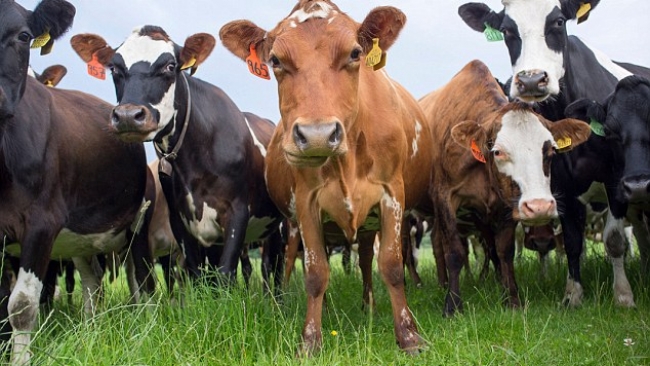Antibiotics make cow pats let off almost twice as much gas

Antibiotics are used to help tackle infections in both humans and animals, but their overuse has led to growing fears of bacteria becoming resistant to the drugs. Yet is also seems the use of antibiotics is also having a negative impact on the environment too.
Researchers have discovered an unexpected side-effect of the use of antibiotics in agriculture – the drugs cause cows to produce dung that is almost twice as gassy as normal.
Methane emissions from livestock are estimated at about 2.2 billion tonnes of carbon dioxide equivalent. 'In the United States, methane from cattle makes up about a quarter of total emissions,' Tobin Hammer, lead author of the study.
It accounts for about 80 per cent of agricultural methane and 35 per cent of the total anthropogenic methane emissions, according to the United Nations.
The study shows antibiotics can affect the microbial emissions of greenhouse gases from cow dung by affecting the microbes in cows' stomachs.
'The routine practice of administering antibiotics to livestock can have unexpected consequences for dung biota and greenhouse gas emissions from agriculture,' researchers said in the study published in the Proceedings of the Royal Society B: Biological Sciences.
A team of researchers in Colorado gave antibiotics to a group of ten cows to test these effects.
'Antibiotic treatment raised methane fluxes from dung, possibly by altering the interactions between methanogenic archaea and bacteria in rumen and dung environments,' the researchers said.
They found treating cows with antibiotic almost doubles the amount of methane coming from their dung.
'The large (1.8-fold) increase in methane emissions from the dung of cattle treated with antibiotics has not been documented, despite the considerable literature on methane production from agricultural systems,' the researchers said.
The researchers think the patterns may be explained by competitive dynamics among gut microbiota.
In the gut of ruminants and other mammals, methanogenic archaea may compete with bacteria for hydrogen, which is often scarce.
Some antibiotics are generally less effective against archaea, which include methanogens found in mammalian digestive tracts.
Therefore, by specifically suppressing bacteria in the gut and subsequently in dung, antibiotics might enable methanogens to outcompete bacteria for hydrogen, increasing their methane output.
Even though methane occurs in lower concentrations than carbon dioxide, it produces 21 times as much warming as carbon dioxide.
It accounts for 20 per cent of the 'enhanced greenhouse effect', according to the BBC Weather Centre.
This study is the first evidence that antibiotics increase the emissions of methane.
'We did not measure belching in this study, and future studies will have to look at this directly, but we think that the antibiotic-induced increase in methane emissions we found in dung will apply to belching as well,' lead author Tobin Hammer.
'Our findings call for analyses at larger scales that take other factors into account, such as the relative importance of dung versus belching in gas emissions, and the global extent and purpose of antibiotic use in livestock production,' the researchers said.
Other researchers have looked at ways of reducing the amount of gas produced in livestock's guts.
A recent study suggested that feeding cows oregano may help cut the amount of gas they release when they belch and fart.
The team behind the most recent research hopes in future the problem will be monitored more closely to work out what the extent of the impact of antibiotics in livestock is on global warming.
'Antibiotics will always be necessary for treating infections, but I do think we should reduce the amount of antibiotics used, especially for growth promotion,' Mr Hammer said.
'There is already a lot of evidence that agricultural use of antibiotics can favor the evolution of antibiotic resistance, and our study shows that there are other issues - namely, an increase in methane emissions from dung, and changes to the microbiome of nontarget wildlife.
'I should note that this effect may differ depending on the particular class of antibiotic that's used, and in our study we focused on a single compound.'
Source: Daily Mail
Wed 25 May 2016 at 08:06
.jpg)
.jpg)

.jpg)
.jpg)
.jpg)